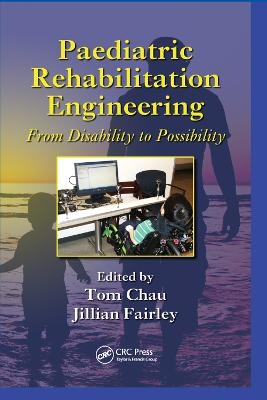
Paediatric Rehabilitation Engineering
From Disability to Possibility
Seiten
2018
CRC Press (Verlag)
978-1-138-37415-7 (ISBN)
CRC Press (Verlag)
978-1-138-37415-7 (ISBN)
Innovations in paediatric rehabilitation engineering can serve as a springboard to education, psychosocial, social, physical and cognitive development for children and youth with disabilities. Instead of providing an overview of rehabilitation engineering, Paediatric Rehabilitation Engineering focuses on the uniqueness of the paediatric subspecialty via an international sampling of methods and techniques currently in use or in development.
The book is divided into three complementary components. The first group of chapters is broadly concerned with connecting individuals to their environment and to the people around them. The second group revolves around paediatric technologies that compensate for compromised or missing function. The final group of chapters is about machines and environments which provide stimulating and interactive platforms for therapy and research.
Topics include:
Microswitch-based occupational, recreational and rehabilitation programs
Emerging access technologies, like infrared thermal imaging and vocal cord vibration detection
Communication technologies to enable children to communicate in a variety of everyday environments
Accessible graphical user and Web-based interface design
Postural and upper and lower extremity compensation, such as customized chairs and prostheses
Global efforts in the area of robotics for autism research
Virtual reality and other interfaces to mitigate motor, communication, and physical control difficulties
Paedriatric rehabilitation engineering offers endless possibilities for future research with implications across the fields of physical and cognitive rehabilitation, medicine, computer science, and policy. It is the harmonizing of the expertise and energies of rehabilitation professionals such as teachers, families, paediatric rehabilitation engineers, and other stakeholders that will ensure that children are optimally supported as they embark on their journey from disability to possibility.
The book is divided into three complementary components. The first group of chapters is broadly concerned with connecting individuals to their environment and to the people around them. The second group revolves around paediatric technologies that compensate for compromised or missing function. The final group of chapters is about machines and environments which provide stimulating and interactive platforms for therapy and research.
Topics include:
Microswitch-based occupational, recreational and rehabilitation programs
Emerging access technologies, like infrared thermal imaging and vocal cord vibration detection
Communication technologies to enable children to communicate in a variety of everyday environments
Accessible graphical user and Web-based interface design
Postural and upper and lower extremity compensation, such as customized chairs and prostheses
Global efforts in the area of robotics for autism research
Virtual reality and other interfaces to mitigate motor, communication, and physical control difficulties
Paedriatric rehabilitation engineering offers endless possibilities for future research with implications across the fields of physical and cognitive rehabilitation, medicine, computer science, and policy. It is the harmonizing of the expertise and energies of rehabilitation professionals such as teachers, families, paediatric rehabilitation engineers, and other stakeholders that will ensure that children are optimally supported as they embark on their journey from disability to possibility.
Tom Chau is a Senior Scientist and Theme Leader of Innovation and Development at the Bloorview Research Institute, the largest pediatric academic rehabilitation hospital in Canada.
Introduction to 21st Century Pediatric Rehabilitation Engineering. Assistive Technology for Cognitive Rehabilitation in Children. Mobile Robotics in the Treatment of Autism. Advances in Pediatric Augmentative and Alternative Communication. Upper Extremity Prosthetics for Children and Youth. Virtual Reality Therapy in Pediatric Rehabilitation. Innovations in Switch Access for Children and Youth with Profound Disabilities. Physiological Access Modalities: Body Talk for Nonverbal Children.
| Erscheinungsdatum | 21.01.2019 |
|---|---|
| Reihe/Serie | Rehabilitation Science in Practice Series |
| Zusatzinfo | 12 Tables, black and white; 91 Illustrations, black and white |
| Verlagsort | London |
| Sprache | englisch |
| Maße | 156 x 234 mm |
| Gewicht | 453 g |
| Themenwelt | Sachbuch/Ratgeber ► Gesundheit / Leben / Psychologie |
| Medizin / Pharmazie ► Allgemeines / Lexika | |
| Medizin / Pharmazie ► Gesundheitsfachberufe | |
| Medizin / Pharmazie ► Physiotherapie / Ergotherapie ► Orthopädie | |
| Medizin / Pharmazie ► Physiotherapie / Ergotherapie ► Rehabilitation | |
| Technik ► Medizintechnik | |
| Technik ► Umwelttechnik / Biotechnologie | |
| ISBN-10 | 1-138-37415-6 / 1138374156 |
| ISBN-13 | 978-1-138-37415-7 / 9781138374157 |
| Zustand | Neuware |
| Haben Sie eine Frage zum Produkt? |
Mehr entdecken
aus dem Bereich
aus dem Bereich
Spiraldynamik - programmierte Therapie für konkrete Resultate
Buch | Hardcover (2021)
Thieme (Verlag)
105,00 €


